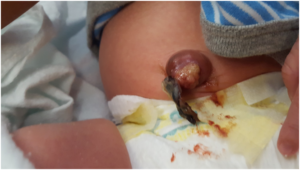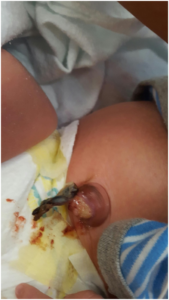Hot Seat #82: 20do M with umbilical concern
Posted on: October 18, 2016, by : Lauren Kinneman
Lauren Kinneman DO, Inova Fairfax Medical Center
With Eiman Abdulrahman MD, Children’s National Medical Center
The Case
A 20 day old full term male presents with a concerning umbilicus. He has had an “outie” since birth, and the umbilical stump has not fallen off entirely but is very close to doing so. He presented to the pediatrician today for a scheduled visit, and the pediatrician sent him to the ED for further evaluation because she “did not like the color” of the umbilicus. According to mother the umbilicus has largely looked like this since birth.
ROS: No fevers, no vomiting, no umbilical erythema, no umbilical bleeding, no diarrhea, feeding normally and gaining weight properly
PMH: Full term, unremarkable birth history
PE:
VS: T 98.8 (rectal), HR 142, RR 30, BP 80/50
Gen: Calm, well appearing infant, no dysmorphic features
HEENT: PERRL, pupils 3-4mm, TMs clear bilaterally, no oral lesions, anterior fontanelle open and flat
Chest: CTAB, heart RRR, no murmurs or gallops
Abd: soft, nontender, nondistended, +BS, no HSM
Umbilical exam: very firm to touch, nontender, appearance as below:
Question 1:
You decide to obtain labs:
CRP: <0.1, CBC WBC: 12 (normal differential), H/H 11/34, plts: 274
An ultrasound was performed, which showed a hyperemic umbilical cord remnant without any evidence of bowel herniation.
Reduction is attempted by the ED physician, but it is unsuccessful and seems to cause the patient discomfort.
Question 2:
How would you approach this case? Please share your opinions by clicking on “What do you think?” below.
The information in these cases has been changed to protect patient identity and confidentiality. The images are only provided for educational purposes and members agree not to download them, share them, or otherwise use them for any other purpose.



With the referral for concern about the umbilicus, the most common serious problem is infection. Given that the baby is acting normally; there is no fever; the umbilicus has not changed in appearance since birth; and there is no sign of cellulitis around the umbilical stump, it does not seem that there is any emergent issue to address. So my first thought was to do no testing and discharge the baby home.
In reviewing the exam and the photo, it sounds as if there is exaggerated prominence and firmness of the stump. And it doesn’t look like just a large granuloma. 2 congenital abnormalities of the umbilicus include omphalomesenteric duct remnants (connection to ileum) and urachal remnants (connection to the bladder). Since there is no actual leakage of fluid, the abnormality could be a cystic malformation. Lacking any clinical experience with these diagnoses, I might ask a Radiology or NICU colleague how to image. Imaging could be done during this visit or as an outpatient.
Looking forward to learning the outcome.
Why not just arrange follow-up with general surgery? No tenderness, no sign of obstruction, no feeding difficulty, no inflammatory markers or signs of infection? I would guess it’s a herniated remnant but doesn’t seem like there is reason to do something acutely. Our job is not always to make a diagnosis, it’s to evaluate for signs of emergency. Even the ultrasound seems like overkill here 😉
Given the lack of cellulitic appearance, change in appearance from birth and lack of drainage, I would be less concerned for abnormal remnants or connections. I would have started with an ultrasound to rule out any emergent surgical steps that need to be taken but looking at that picture and being reassured there is no bowel entrapped within, my next thought would be an umbilical polyp which would not respond to silver nitrate like granulomas would so I believe surgical input would be needed to excise and possibly send for histopathology. With that being said I am sure this could all be arranged with outpatient follow up and elective surgery.
My thoughts are along the same lines as Jen’s and I only felt comfortable with Dave’s comment on outpatient follow up after learning more about the umbilical abnormalities.
In an almost three-week-old with umbilical concerns I am usually, first and foremost, ruling out infectious causes—specifically omphalitis. I feel comfortable it is not infectious after looking at the picture and the reassuring history of no fever/vomiting, umbilicus unchanged since birth and physical exam of no erythema/edema surrounding skin around umbilicus.
After ruling out infectious process, I am still thinking that this is outside of the normal variation of granulation tissue I typically see and I will need to review the differentials of umbilical abnormalities. I agree with Dave that there doesn’t seem to be anything emergent to deal with, but I feel a little uncomfortable discharging an infant when I am not quite sure what I am dealing with.
In a busy shift in the ED, I would likely get an US to get any additional information on what I am seeing in this infant. This is one of those cases where it will be helpful to review the embryology of umbilical cord formation and complications that arise from normal development. Leukocyte Adhesion Deficiency is something that is always tested on boards, and although I have never seen a case I am not thinking that in this situation. The cord looks like it is falling off and the issue I have with this infant’s umbilicus is the base of surrounding tissue that almost looks like a stoma with granulation tissue in the middle.
In looking at up-to-date:
Umbilicus is composed of three parts mamelon-area of central depression, cicatrix- dense scar, and cushion- slightly raised margin around the mamelon and cicatrix. There are 60 reported variations of normal, but it can also be as sign of genetic abnormality so looking at the infant’s feature more carefully will be helpful.
Omphalomesenteric duct anomalies arise when this embryologic remnant doesn’t involute and results in varying degrees of connection of umbilicus and terminal ileum. When there is complete patency then there will be intestinal drainage from the umbilicus and the family would have noticed a foul smell. Umbilical polyp is where there is persistent tissue with no connection to the terminal ileum. This is a high possibility in this case.
Urachal anomalies occur when the urachus does not involute into a fibrous cord between umbilicus and bladder. When this happens and you have a patent cord with free communication between umbilicus and bladder, it will be noticeable to the family who should note wetness around the umbilicus.
My worry initially is that I did not know if there are anomalies that need immediate evaluation even when an infant is asymptomatic. After reading up on umbilical abnormalities and realizing that patent remnants from the bladder or ileum is something that is evident by history and exam, I don’t see the urgency in doing further imaging. I certainly will not attempt silver nitrate in a case where I am not sure what I am dealing with.
Overall, this is likely a polyp and further evaluation may be necessary to r/o Meckels’ etc., but not something that will need further evaluation in the Emergency department other than an Ultrasound.